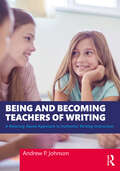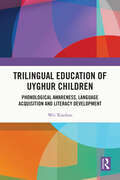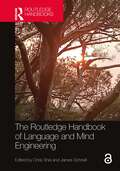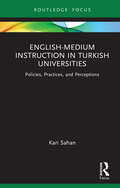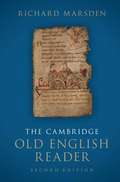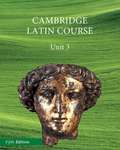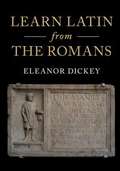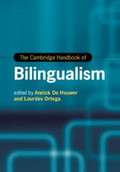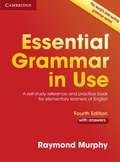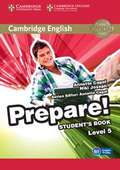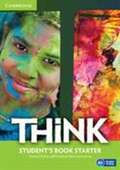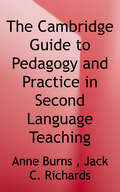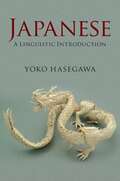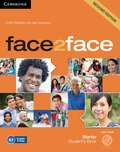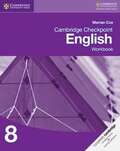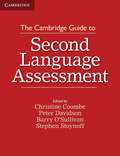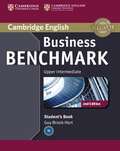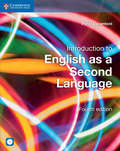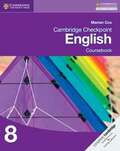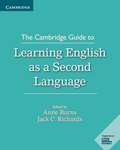- Table View
- List View
Being and Becoming Teachers of Writing: A Meaning-Based Approach to Authentic Writing Instruction
by Andrew P. JohnsonThis engaging, inviting textbook from a renowned expert in writing education provides all the knowledge, pedagogical strategies, and tools needed to enable any teacher to be an effective teacher of writing.Using the five-step writing process as a foundation, the text describes how to teach the necessary skills related to grammar, spelling, punctuation, and other writing mechanics, and addresses all major genres and stages of writing. Written in an authentic voice that exemplifies good writing, Johnson presents a variety of pragmatic, research-based strategies that support students’ writing development and encourage teachers to apply their own creativity and intelligence in the classroom.This is an essential text for courses in writing instruction, literacy methods, and teaching English Language Arts (ELA).
Trilingual Education of Uyghur Children: Phonological Awareness, Language Acquisition and Literacy Development
by Wei XiaobaoGiven the differences in the orthographic structure of the Uyghur, Chinese and English languages, this study used a mixed-method approach to systematically describe and analyze the phonological awareness of Uyghur bilingual children as English learners and its contributions to their trilingual literacy acquisition and development.Focusing on the development of these learners' phonological awareness in Uyghur, Chinese and English, this study explored the influences of Uyghur and Chinese learning on the formation of their English phonological awareness and the roles of different components of phonological awareness in their trilingual literacy development. Based on the characteristics of the phonetic structure in Uyghur, Chinese and English and the development of Uyghur children's phonological awareness in these languages, a Chinese phonetic identification training and Uyghur–Chinese–English comprehensive phonetic training program (including intensive phoneme category contrast training and phonics training) was designed to explore whether such targeted phonetic identification training can effectively improve these children's phonological awareness in Chinese and English and thus further promote their trilingual literacy development.This book will appeal to researchers and students interested in the fields of psycholinguistics, language acquisition and multilingual education.
Trilingual Education of Uyghur Children: Phonological Awareness, Language Acquisition and Literacy Development
by Wei XiaobaoGiven the differences in the orthographic structure of the Uyghur, Chinese and English languages, this study used a mixed-method approach to systematically describe and analyze the phonological awareness of Uyghur bilingual children as English learners and its contributions to their trilingual literacy acquisition and development.Focusing on the development of these learners' phonological awareness in Uyghur, Chinese and English, this study explored the influences of Uyghur and Chinese learning on the formation of their English phonological awareness and the roles of different components of phonological awareness in their trilingual literacy development. Based on the characteristics of the phonetic structure in Uyghur, Chinese and English and the development of Uyghur children's phonological awareness in these languages, a Chinese phonetic identification training and Uyghur–Chinese–English comprehensive phonetic training program (including intensive phoneme category contrast training and phonics training) was designed to explore whether such targeted phonetic identification training can effectively improve these children's phonological awareness in Chinese and English and thus further promote their trilingual literacy development.This book will appeal to researchers and students interested in the fields of psycholinguistics, language acquisition and multilingual education.
The Routledge Handbook of Language and Mind Engineering
The Routledge Handbook of Language and Mind Engineering is a comprehensive work that delves into the complex interplay between language, culture, politics, and media in shaping the human mind.The book is divided into five main sections, each exploring different aspects of mind engineering: I. Political Mind Engineering; II. Commercial Mind Engineering; III. Media, Culture, and Mind Engineering; IV. Linguistic and Semiotic Analysis of Mind Engineering; V. Mind Engineering in Educational Settings.The book provides a multi-dimensional perspective on how language, media, culture, and politics intersect to shape individuals' thoughts and beliefs. It highlights the diverse methods and contexts in which mind engineering occurs, making it a valuable resource for scholars, researchers, and policymakers interested in understanding the complexities of contemporary discourse and manipulation of human thought.The contents of this cutting-edge handbook will engage all undergraduate, postgraduate, PhD students and scholars, and researchers at all levels, in fields such as languages, linguistics, politics, communication studies, media studies, and psychology.Chapter 15 of this book is freely available as a downloadable Open Access PDF at http://www.taylorfrancis.com under a Creative Commons Attribution (CC-BY) International license.Chapter 17 of this book is freely available as a downloadable Open Access PDF at http://www.taylorfrancis.com under a Creative Commons Attribution‑Non Commercial‑No Derivatives (CC‑BY‑NC‑ND) 4.0 license.Chapter 18 of this book is freely available as a downloadable Open Access PDF at http://www.taylorfrancis.com under a Creative Commons Attribution-Non Commercial-No Derivatives (CC-BY-NC-ND) 4.0 license.
The Routledge Handbook of Language and Mind Engineering
by Chris Shei James SchnellThe Routledge Handbook of Language and Mind Engineering is a comprehensive work that delves into the complex interplay between language, culture, politics, and media in shaping the human mind.The book is divided into five main sections, each exploring different aspects of mind engineering: I. Political Mind Engineering; II. Commercial Mind Engineering; III. Media, Culture, and Mind Engineering; IV. Linguistic and Semiotic Analysis of Mind Engineering; V. Mind Engineering in Educational Settings.The book provides a multi-dimensional perspective on how language, media, culture, and politics intersect to shape individuals' thoughts and beliefs. It highlights the diverse methods and contexts in which mind engineering occurs, making it a valuable resource for scholars, researchers, and policymakers interested in understanding the complexities of contemporary discourse and manipulation of human thought.The contents of this cutting-edge handbook will engage all undergraduate, postgraduate, PhD students and scholars, and researchers at all levels, in fields such as languages, linguistics, politics, communication studies, media studies, and psychology.Chapter 15 of this book is freely available as a downloadable Open Access PDF at http://www.taylorfrancis.com under a Creative Commons Attribution (CC-BY) International license.Chapter 17 of this book is freely available as a downloadable Open Access PDF at http://www.taylorfrancis.com under a Creative Commons Attribution‑Non Commercial‑No Derivatives (CC‑BY‑NC‑ND) 4.0 license.Chapter 18 of this book is freely available as a downloadable Open Access PDF at http://www.taylorfrancis.com under a Creative Commons Attribution-Non Commercial-No Derivatives (CC-BY-NC-ND) 4.0 license.
English-Medium Instruction in Turkish Universities: Policies, Practices, and Perceptions (Routledge Focus on English-Medium Instruction in Higher Education)
by Kari SahanIn response to the growing use of English as an international language, the number of English-medium instruction (EMI) programs in higher education has increased. However, decisions to implement EMI programs are often made through top-down policymaking processes with little consideration for the educational issues surrounding language policy changes.This book examines the variation with which EMI is implemented at universities in Turkey through a multilevel empirical investigation of policies, practices, and perceptions. In addition to providing a sociohistorical overview of EMI in Turkey, the book draws on a dataset that includes policy documents, classroom observations, interviews with teachers, and focus group discussions with students. Despite national policies which envision a "one-language-at-a-time" model of EMI education, this book argues that EMI is neither English-only nor English-always in practice. By highlighting the variation with which EMI is implemented at and across Turkish universities, this study illustrates the need for more comprehensive EMI policies and processes aimed at integrating content and language learning in higher education.Implications are discussed with respect to policy planning, program development, and pedagogical support and will be relevant for researchers and postgraduate research students interested in EMI, particularly in the Turkish context.
English-Medium Instruction in Turkish Universities: Policies, Practices, and Perceptions (Routledge Focus on English-Medium Instruction in Higher Education)
by Kari SahanIn response to the growing use of English as an international language, the number of English-medium instruction (EMI) programs in higher education has increased. However, decisions to implement EMI programs are often made through top-down policymaking processes with little consideration for the educational issues surrounding language policy changes.This book examines the variation with which EMI is implemented at universities in Turkey through a multilevel empirical investigation of policies, practices, and perceptions. In addition to providing a sociohistorical overview of EMI in Turkey, the book draws on a dataset that includes policy documents, classroom observations, interviews with teachers, and focus group discussions with students. Despite national policies which envision a "one-language-at-a-time" model of EMI education, this book argues that EMI is neither English-only nor English-always in practice. By highlighting the variation with which EMI is implemented at and across Turkish universities, this study illustrates the need for more comprehensive EMI policies and processes aimed at integrating content and language learning in higher education.Implications are discussed with respect to policy planning, program development, and pedagogical support and will be relevant for researchers and postgraduate research students interested in EMI, particularly in the Turkish context.
The Cambridge Old English Reader (PDF)
by Richard MarsdenThis reader remains the only major new reader of Old English prose and verse in the past forty years. The second edition is extensively revised throughout, with the addition of a new 'Beginning Old English' section for newcomers to the Old English language, along with a new extract from Beowulf. The fifty-seven individual texts include established favourites such as The Battle of Maldon and Wulfstan's Sermon of the Wolf, as well as others not otherwise readily available, such as an extract from Apollonius of Tyre. Modern English glosses for every prose-passage and poem are provided on the same page as the text, along with extensive notes. A succinct reference grammar is appended, along with guides to pronunciation and to grammatical terminology. A comprehensive glossary lists and analyses all the Old English words that occur in the book. Headnotes to each of the six text sections, and to every individual text, establish their literary and historical contexts, and illustrate the rich cultural variety of Anglo-Saxon England. This second edition is an accessible and scholarly introduction to Old English.
North American Cambridge Latin Course Unit 3 Student's Book (PDF)
by University of Cambridge School ClassicsDeveloped by the University of Cambridge School Classics Project, this bestselling Latin program provides an enjoyable and carefully paced introduction to the Latin language, complemented by background information on Roman culture and civilization. Starting in Roman Britain and moving on to imperial Rome itself, Unit 3 focuses on the murderous schemes and machinations of Gaius Salvius Liberalis, as he plots his ruthless and apparently unstoppable rise to power. 9781107675780
Learn Latin From The Romans: A Complete Introductory Course Using Textbooks From The Roman Empire (PDF)
by Eleanor DickeyLearn Latin from the Romans is the only introductory Latin textbook to feature texts written by ancient Romans for Latin learners. These texts, the 'colloquia', consist of dialogues and narratives about daily life similar to those found in modern-language textbooks today, introducing learners to Roman culture as well as to Latin in an engaging, accessible, and enjoyable way. Students and instructors will find everything they need in one complete volume, including clear explanations of grammatical concepts and how Latin works, both British and American orders for all noun and adjective paradigms, 5,000 easy practice sentences, and over 150 longer passages (from the colloquia and a diverse range of other sources including inscriptions, graffiti, and Christian texts as well as Catullus, Cicero, and Virgil). Written by a leading Latin linguist with decades of language teaching experience, this textbook is suitable for introductory Latin courses worldwide.
The Cambridge Handbook of Bilingualism (PDF)
by Edited by Annick De Houwer Lourdes OrtegaThe ability to speak two or more languages is a common human experience, whether for children born into bilingual families, young people enrolled in foreign language classes, or mature and older adults learning and using more than one language to meet life’s needs and desires. This Handbook offers a developmentally oriented and socially contextualized survey of research into individual bilingualism, comprising the learning, use, and, as the case may be, unlearning of two or more spoken and signed languages and language varieties. A wide range of topics is covered, from ideologies, policy, the law, and economics, to exposure and input, language education, measurement of bilingual abilities, attrition and forgetting, and giftedness in bilinguals. Also explored are cross- and intradisciplinary connections with psychology, clinical linguistics, second language acquisition, education, cognitive science, neurolinguistics, contact linguistics, and sign language research.
A Guide To Biblical Hebrew Syntax: (PDF)
by Bill T. Arnold John H. ChoiA Guide to Biblical Hebrew Syntax introduces and abridges the syntactical features of the original language of the Hebrew Bible/Old Testament. An intermediate-level reference grammar for Biblical Hebrew, it assumes an understanding of elementary phonology and morphology, and it defines and illustrates the fundamental syntactical features of Biblical Hebrew that most intermediate-level readers struggle to master. The volume divides Biblical Hebrew syntax and morphology into four parts. The first three cover the individual words (nouns, verbs, and particles) with the goal of helping the reader move from morphological and syntactical observations to meaning and significance. The fourth section moves beyond phrase-level phenomena and considers the larger relationships of clauses and sentences. Since publication of the first edition, research on Biblical Hebrew syntax has substantially evolved. This new edition incorporates these developments through detailed descriptions of grammatical phenomena from a linguistics approach. It retains the labels and terminology used in the first edition to maintain continuity with the majority of entry-level and more advanced grammars.
Essential Grammar In Use With Answers (4th Edition) (PDF)
by MurphyraymondThe world's best-selling grammar series for learners of English. Essential Grammar in Use is a self-study reference and practice book for elementary-level learners (A1-B1), used by millions of people around the world. With clear examples, easy-to-follow exercises and answer key, the Fourth edition is perfect for independent study, covering all the areas of grammar that you will need at this level. The book has an easy-to-use format of two-page units with clear explanations of grammar points on the left-hand page, and practice exercises on the right. It also includes plenty of additional exercises and a Study Guide to help you find the grammar units you need to study.
Essential Grammar In Use. With Answers. Per Le Scuole Superiori. Con E-book. Con Espansione Online (PDF)
by Raymond MurphyGrammar in Use is the world's best-selling grammar series for learners of English. Essential Grammar in Use with Answers, authored by Raymond Murphy, is the first choice for elementary-level (A1-B1) learners and covers all the grammar required at this level. It is a self-study book with simple explanations and lots of practice exercises, and has helped millions of people around the world to communicate in English. It is also trusted by teachers and can be used as a supplementary text in classrooms.
Cambridge English Prepare! Level 5. Student's Book. Per Le Scuole Superiori. Con Espansione Online (Cambridge English Prepare! Ser.)
by Joanna KostaPrepare! is a lively 7-level general English course with comprehensive Cambridge English for Schools exam preparation integrated throughout. This flexible course brings together all the tools and technology you expect to get the results you need. Whether teaching general English or focusing on exams, Prepare! leaves you and your students genuinely ready for what comes next: real Cambridge English exams, or real life. The Level 5 Student's Book engages students and builds vocabulary range with motivating, age-appropriate topics. Its unique approach is driven by cutting-edge language research from English Profile and the Cambridge Learner Corpus. 'Prepare to...' sections develop writing and speaking skills. A Student's Book and Online Workbook is also available, separately.
Think Starter Student's Book (Think Ser.)
by Herbert PuchtaChallenge and inspire your teenage learners to think beyond language Think is a vibrant course designed to engage teenage learners and make them think As well as building students language skills it offers a holistic approach to learning developing their thinking skills encouraging them to reflect on values and building selfesteem Topics are chosen to appeal to and challenge teenagers firing their imagination and ensuring effective learning Examstyle exercises and tips help students prepare for Cambridge English Key Preliminary and First Informed by the Cambridge English Corpus the course reflects real language usage and Get it right sections help students avoid common mistakes
The Cambridge Guide To Pedagogy And Practice In Second Language Teaching (PDF)
by Anne BurnsThis collection of original articles provides a state-of-the-art overview of key issues and approaches in contemporary language teaching. Written by internationally prominent researchers, educators, and emerging scholars, the chapters are grouped into five sections: rethinking our understanding of teaching, learner diversity and classroom learning, pedagogical approaches and practices, components of the curriculum, and media and materials. Each chapter covers key topics in teaching methodology such as reflective pedagogy, teaching large classes, outcomes-based language learning, speaking instruction, and technology in the classroom. Chapters assume no particular background knowledge and are written in an accessible style.
Japanese (PDF): A Linguistic Introduction
by Yoko HasegawaThis comprehensive introduction to the Japanese language consists of six parts. Following the introductory section, it explores the Japanese lexicon, grammatical foundations, major clause types, clause linkage, and language usage. The discussion of formal and structural properties of Japanese such as sound structure, vocabulary and grammar assist readers as they gain insight into historical and sociocultural aspects of Japanese; some are compared with those of English-speaking nations. An ideal choice for instructors, the book includes twenty-eight chapters, sufficient for approximately ninety hours of hands-on instruction. Each topic has been rigorously selected based on the author's experience of more than two decades teaching Japanese linguistics. The book's breadth and depth make it highly appropriate for learners of the Japanese language, for linguistics students interested in Japanese, and for researchers interested in Japanese linguistics. Online resources include exercises and supplementary multimedia materials to enhance the reader's comprehension and enjoyment.
Face2face Starter Student's Book (2nd Edition) (PDF)
by Redston Chrisface2face Second edition is the flexible, easy-to-teach, 6-level course (A1 to C1) for busy teachers who want to get their adult and young adult learners to communicate with confidence. The fully updated and redesigned Starter Student's Book provides 60-90 hours of material, with a clear focus on improving students' listening and speaking skills. It comes with a free DVD-ROM which includes consolidation activities and an electronic portfolio for learners to track their progress with customisable tests, and grammar and vocabulary reference sections. The Student's Book includes new optional video for the Real World lessons (video available on the Teacher's DVD) with vocabulary selection informed by English Profile and the Cambridge Learner Corpus. (Please note that the face2face Second edition Class Audio CDs are available separately.)
Cambridge Checkpoint English Workbook 8 (PDF)
by Marian CoxThe Cambridge Checkpoint English suite provides a comprehensive, structured resource which covers the Secondary 1 framework for English and seamlessly progresses into the next key stage (covered by our Cambridge IGCSE® First Language English series). Designed to be used alongside the Cambridge Checkpoint English Coursebook 8, this accessible, write-in workbook provides exercises to help students build on the skills taught in the Coursebook, for differentiation, and further practice in the classroom or at home. The 12 themed units mirror the structure and content of the Coursebook, and answers to the exercises are included on the Teacher's Resource CD-ROM, which is available separately.
The Cambridge Guide To Second Language Assessment (PDF)
by Christine CoombeThis collection of original articles provides language teachers with a theoretical background of key issues associated with language testing as well as practical advice on how to improve the effectiveness of the tests they develop and implement. Written by internationally prominent researchers and educators, the chapters are organized into five sections: key issues in the field, assessment purposes and approaches, assessment of second language skills, technology in assessment, and administrative issues. Chapters assume no particular background knowledge and are written in an accessible style.
Business Benchmark - Upper Intermediate (PDF)
by Guy Brook-HartBusiness Benchmark Second edition is the official Cambridge English preparation course for Cambridge English: Business Preliminary, Vantage and Higher (also known as BEC), and BULATS. A pacy, topic-based course with comprehensive coverage of language and skills for business, it motivates and engages both professionals and students preparing for working life. The Business Vantage Student's Book contains authentic listening and reading materials, including interviews with business people, providing models for up‐to‐date business language. Grammar and vocabulary exercises train students to avoid common mistakes, identified using Cambridge's unique collection of real exam candidates' answers. 'Grammar workshops' practise grammar in relevant business contexts. A BULATS version of this Student's Book is also available.
Introduction To English As A Second Language Coursebook With Audio Cd (Cambridge International IGSCE)
by Peter LucantoniIntroduction to English as a Second Language is a course to prepare students for studying at IGCSE or equivalent level. Presented in a colourful updated design and offering clear, practical support for students, it follows a variety of interesting themes and topics, with a focus on skills development: listening, speaking, reading and writing. Each unit provides opportunities for thinking and discussion, along with developing research and study skills. Furthermore, each unit has a specific language-focus section to revise and consolidate key areas of language awareness and activities for vocabulary building. Audio CD is included for use with the listening activities.
Cambridge Checkpoint English Coursebook 8
by Marian CoxReading books is a kind of enjoyment. Reading books is a good habit. We bring you a different kinds of books. You can carry this book where ever you want. It is easy to carry. It can be an ideal gift to yourself and to your loved ones. Care instruction keep away from fire.
The Cambridge Guide to Learning English as a Second Language (PDF)
by Edited by Anne Burns Jack C. RichardsThis volume provides an up-to-date and comprehensive coverage of second language learning. The focus throughout the book is primarily on language learning, but each chapter also discusses the implications for teaching and assessment, thus informing both understanding and practice. The book contains nine sections, which aim to organise and reflect different dimensions of the diverse and complex scope of learning English as a second or additional language. Four themes which permeate the chapters are: learning and learners; learning and language; learning and language development; learning and learning context. The 36 chapters are up-to-date and authoritative, written by experts in the field. The content is accessibly written, with questions for discussion and follow-up reading suggestions provided.
